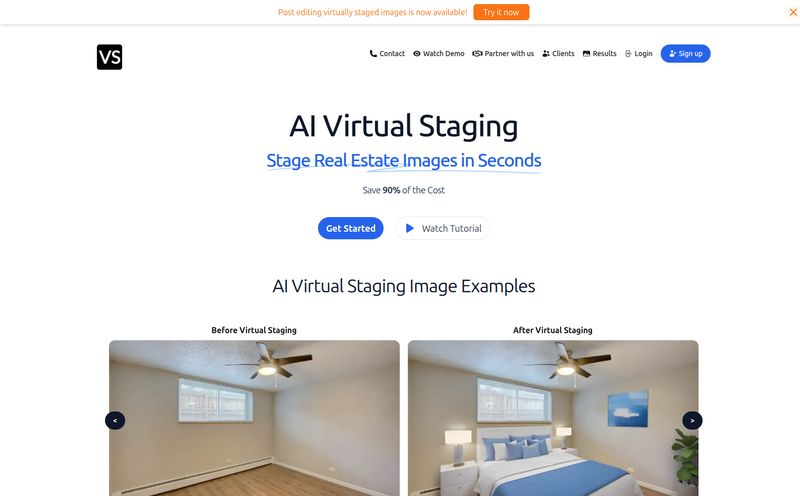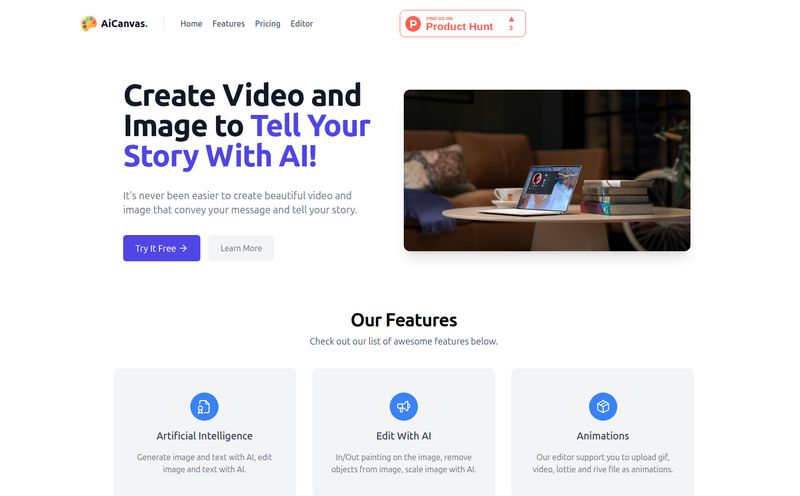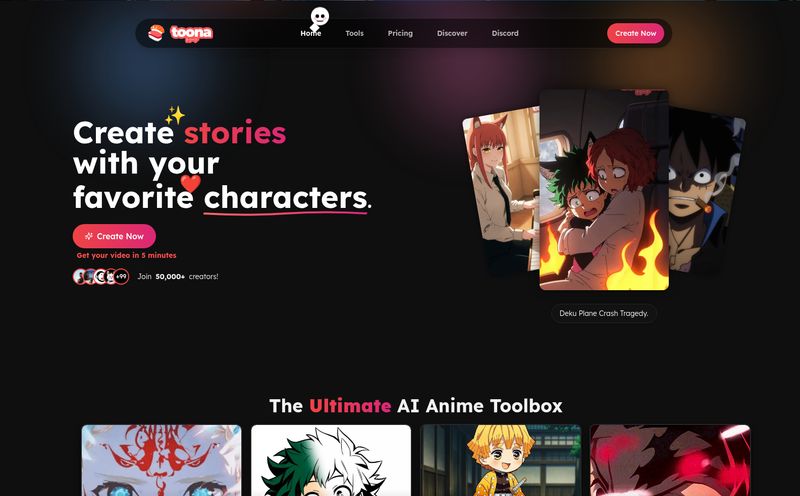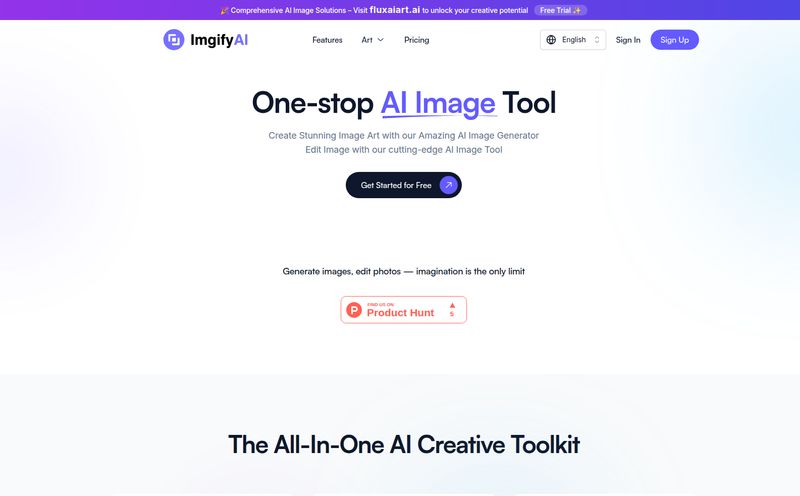We’ve all been there. You get the perfect shot. The lighting is magical, everyone’s smiling (a genuine smile, not the hostage-situation kind), and the composition is spot on. Then you look closer. Right there, smack in the middle of your friend’s face, is a huge, distracting glare on their glasses. Or worse, the frames are hiding their eyes entirely. Ugh. For years, fixing this meant one of two things: either living with it, or spending hours in Photoshop performing the digital equivalent of open-heart surgery. A nightmare of clone stamping, healing brushes, and trying to literally paint new eyes. It's a skill, for sure, but one that most of us just dont have the time or patience for.
But we live in the future now, right? AI is writing our emails and creating bizarre images of historical figures at the gym. So, it stands to reason that it should be able to tackle something as common as removing specs from a photo. That’s the promise of a tool I recently stumbled upon called Glasses Gone. The name is… direct. I’ll give it that. But can a simple, browser-based tool really do what used to take a professional retoucher hours of painstaking work? I was skeptical, but also intrigued. So I decided to put it through its paces.
What Exactly is Glasses Gone?
In a nutshell, Glasses Gone is a specialized AI tool designed for one specific task: to digitally remove eyeglasses from portrait photos. You upload an image, the AI brain does its thing, and you get back a photo with a clear, unobscured face. It’s part of a growing trend of single-purpose AI tools that aim to do one thing exceptionally well, rather than being a bloated, all-in-one editor. Think of it less like the Swiss Army knife of Adobe Photoshop and more like a high-quality corkscrew. It doesn't do a million things, but it promises to open that bottle of wine perfectly every time.
The core technology relies on a trained algorithm that has seen thousands of faces, with and without glasses. It learns to identify the frames and lenses, understand the underlying facial structure, and then reconstruct the parts of the face that were covered up—namely the eyes and the bridge of the nose. It's a fascinating and complex process, all hidden behind a deceptively simple interface.
Putting It to the Test: My First Impressions
Landing on the Glasses Gone website, I was struck by how minimalist it is. There are no flashy animations, no confusing menus. Just a simple formula: 🤓 + 🪄 = 😊. Cute. And below that, a box to enter your email and an upload button. That’s it. My inner cynic immediately kicked in. Really? That’s all there is to it? It felt almost too easy. In my years of dealing with photo software, “easy” often means “doesn’t work well.”
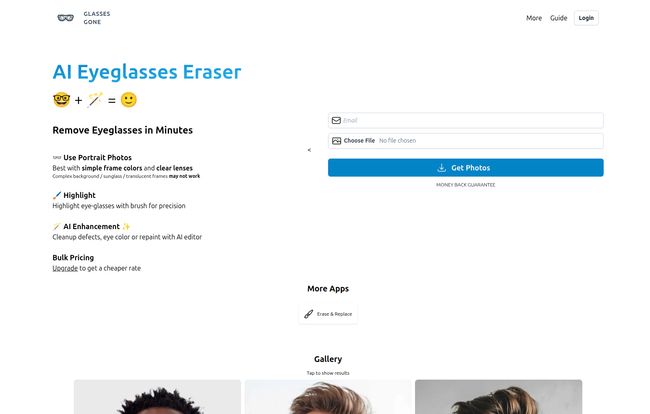
Visit Glasses Gone
So, I grabbed a few test photos. The site itself gives you a heads-up on what works best: clear portrait photos, simple frame colors, and clear lenses. It explicitly warns that complex backgrounds, sunglasses, or funky translucent frames might not work. Honesty in an AI tool? I appreciate that. I started with an easy one: a standard headshot of a friend with thin, dark frames. I uploaded the file, crossed my fingers, and waited.
The Good, The Bad, and The AI's Best Guess
Let's get down to brass tacks. Does it work? The short answer is: yes, but with some pretty important caveats. It’s not a magic wand you can wave at any photo, but in the right conditions, the results are genuinely impressive.
Where It Shines: The Wins
On my first test photo—the simple headshot—it did a fantastic job. The glasses were gone, and the eyes underneath looked natural. There were no weird digital artifacts or smudges where the frames used to be. The AI had successfully rebuilt the skin on the bridge of the nose and the areas around the eyes. It was clean. For a one-click solution, it was honestly miles ahead of what I could achieve in the same amount of time. The biggest win here is speed and simplicity. For a busy photographer or even just a regular person wanting to fix a family photo, this is a game-changer.
The tool also offers some extra AI enhancement features, like cleaning up minor blemishes or even changing eye color. These are nice little bonuses that add value beyond the main event. And, perhaps most reassuringly, they offer a money-back guarantee. That shows a level of confidence in their product that you don’t always see.
The Caveats: Where You Might Get Stuck
Now for the reality check. This tool is a specialist, and it gets picky. I decided to throw it a curveball: a photo of someone with thick, tortoiseshell frames, slightly turned away from the camera. The result? Well, it was… okay. The AI got a little confused around the temples and the eyes it generated felt a bit off. It wasn't terrible, but it wouldn't fool a discerning eye. It confirmed what the site already told me: simple frames, looking straight ahead, is the formula for success.
So, if you’re trying to remove a pair of giant, reflective aviator sunglasses from a photo taken at a music festival, this ain’t it. The AI has to make an educated guess about what the eyes look like underneath, and with sunglasses, it's just guessing in the dark. The same goes for very thick or translucent frames that distort the face shape. The AI can get lost in the details. It's a limitation of the current tech, and it's good to know where that line is drawn.
Beyond Just Removing Glasses: The Extra Features
I was pleasantly surprised to see it wasn't just a one-trick pony. After the AI does its initial pass, you get access to a few more tools. There's a brush tool that lets you highlight the glasses with more precision. This is a brilliant touch. It gives you a bit of manual control, helping the AI focus on the right areas. If the automated process misses a spot, you can guide it. I love this because it bridges the gap between a fully automated, hands-off tool and a more professional editor.
The other "AI Enhancement" features, like the defect cleanup and eye color changer, are fun additions. You can quickly remove a stray pimple or experiment with a different eye color. This pushes Glasses Gone from being a simple utility into the realm of a light portrait retouching platform. It's smart. Once you've fixed the glasses, why not touch up the rest of the portrait while you're there?
The Million-Dollar Question: What's the Price?
Ah, the all-important question of cost. And here's where things get a little fuzzy. The homepage mentions "Bulk Pricing" for a cheaper rate, which immediately tells me it's not a completely free tool. Naturally, I went looking for a pricing page to get the details. And I clicked… right into a '404 Page Not Found' error. Whoops. A little hiccup on their end, it seems.
While I couldn't find a concrete price list, the mention of bulk pricing suggests a credit-based or pay-per-image model, which is common for services like this. This would make a lot of sense for professional photographers who might need to process a batch of 50 photos from a wedding or corporate event. For casual users, I'd expect a smaller package or a per-photo fee. My advice? Check their site directly, as they'll likely have this fixed by the time you're reading this. The lack of transparent pricing is a small knock against them, but likely just a temporary web glitch.
Who is This Tool Actually For?
After playing around with it, a few clear user profiles come to mind:
- The Professional Portrait Photographer: This is a lifesaver for those moments when glare ruins an otherwise perfect client headshot. The potential for bulk processing makes it a viable tool to add to the workflow for quick, efficient edits.
- The Social Media Manager: Need to get a consistent look for the company's 'About Us' page? This tool can quickly standardize headshots and remove distracting glasses.
- The Everyday Person: Got a fantastic family photo for the holiday card, but Grandma’s glasses have a weird reflection? This is a fast, easy fix that doesn’t require you to learn a whole new software.
It’s not for the digital artist who wants granular control or the person trying to salvage a really complex, messy photo. It's for people who value time and convenience for a very specific problem.
How Does Glasses Gone Compare to Photoshop?
It’s tempting to compare Glasses Gone directly to a powerhouse like Adobe Photoshop, but it's like comparing a go-kart to a freight train. They’re both vehicles, but they have wildly different purposes.
Doing this in Photoshop gives you ultimate control. You can manually rebuild every pixel, adjust lighting, match skin texture, and achieve flawless results... if you have the skill and several hours to spare. It's powerful, but it has a steep learning curve and a monthly subscription fee.
Glasses Gone is the opposite. It’s all about speed and automation. You give up control for convenience. You can't tweak the algorithm or manually paint the eyelashes. You press a button and get a result in seconds. For 80% of the simple cases, that result is probably good enough. It's the classic 80/20 rule in action.
Ultimately, they serve different masters. Photoshop is the professional's workshop; Glasses Gone is the handy gadget for a quick fix.
So, what's the verdict? I have to say, I'm pleasantly surprised. Glasses Gone knows what it is and, more importantly, what it isn't. It’s not a magical cure-all for every photo problem. But as a specialized AI tool for removing simple eyeglasses from portraits, it works remarkably well. It’s a fantastic example of how AI can automate tedious tasks and make photo editing more accessible to everyone. It’s fast, it’s focused, and for the right photo, it feels a little bit like magic. Just, you know, the practical kind.
Frequently Asked Questions
- Is Glasses Gone free to use?
- It doesn't appear to be completely free. The site mentions "Bulk Pricing" and requires an email to process photos, which suggests a pay-per-image or credit-based system. You should check their website for the most current pricing information.
- Can Glasses Gone remove sunglasses or tinted lenses?
- No, the tool is not designed for sunglasses or heavily tinted lenses. The AI needs to see the eye behind the lens to work effectively. It performs best with clear lenses.
- What kind of photos work best with Glasses Gone?
- For the best results, use clear, well-lit portrait photos where the person is looking straight at the camera. Simple, thin frames work much better than thick, complex, or translucent ones.
- Do I need any photo editing skills to use it?
- Not at all. The interface is incredibly simple—you just upload your photo. While there is a brush tool for more precise highlighting, the basic process is fully automated and requires no prior experience.
- Is there a money-back guarantee?
- Yes, the website advertises a money-back guarantee, which provides some security if you're not happy with the results of a paid conversion.
- How does the AI rebuild the eyes after removing the glasses?
- The AI uses a generative model trained on thousands of facial images. It analyzes the visible parts of the face and eyes to predict and reconstruct the areas obscured by the frames and lenses, generating new pixels that look natural and match the rest of the face.
Reference and Sources
- Glasses Gone Official Website (Note: This is a placeholder link for the tool)
- PetaPixel: The Rise of AI in Photography - An article discussing the broader trend of AI in the photo industry.
